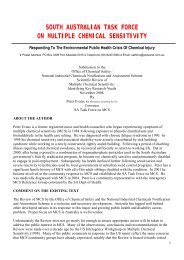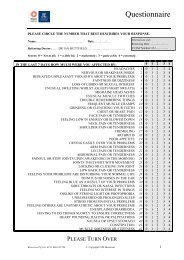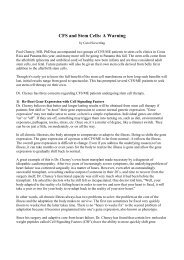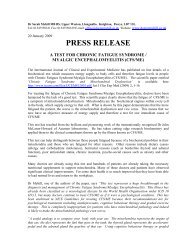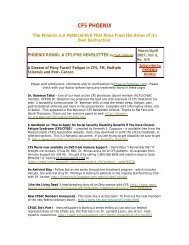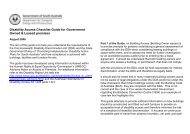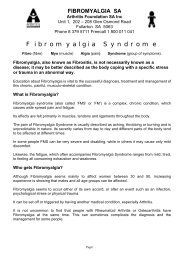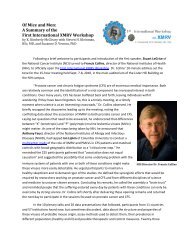ORIGINAL ARTICLEReumatismo, 2008; 60: Supplemento 1: 36-49The evaluation of the fibromyalgia patientsLa valutazione del paziente fibromialgicoF. Atzeni 1 , F. Salaffi 2 , L. Bazzichi 3 , R.H. Gracely 4 , R. Carignola 5 , R. Torta 6 , R. Gorla 7 , A. Marsico 8 ,F. Ceccherelli 9 , M. Cazzola 10 , D. Buskila 11 , M. Spath 12 , M. Di Franco 13 , G. Biasi 14 , G. Cassisi 15 ,S. Stisi 16 , R. Casale 17 , L. Altomonte 18 , G. Arioli 19 , A. Alciati 20 , G. Leardini 21 , F. Marinangeli 22 ,M.A. Giamberardino 23 , P. Sarzi-Puttini 1 (Italian Fibromyalgia Network)1Rheumatology Unit, L. Sacco University Hospital, Milan, Italy; 2 Department of Rheumatology, Polytechnic University of the MarcheRegion, Ancona, Italy; 3 Department of Internal Medicine, Division of Rheumatology, S. Chiara Hospital, University of Pisa, Italy;4Department of Medicine, University of Michigan Health System, Ann Arbor, Michigan, USA; 5 Department of Neuroscience, Universityof Turin, A.S.O. San Giovanni Battista of Turin, Turin, Italy; 6 Department of Neuroscience, University of Turin, A.S.O. San GiovanniBattista of Turin, Turin, Italy; 7 Rheumatology and Clinical Immunology, Spedali Civili and University of Brescia, Italy; 8 RheumatologyUnit, Hospital of Taranto, Taranto, Italy; 9 IOV (Veneto Cancer Institute), IRCCS, Department of Pharmacology and Anesthesiology,University of Padua, Italy; 10 Unit of Rehabilitative Medicine “Hospital of Circolo”, Saronno (VA), Italy; 11 Department of Medicine H,Soroka Medical Center and Faculty of Health Sciences, Ben Gurion University, Beer Sheva, Israel; 12 Friedrich-Baur-Institute,University of Munich, Munich, Germany; 13 Chair of Rheumatology, University la Sapienza Rome, Rome, Italy; 14 Unit of Rheumatology,University of Siena, Siena, Italy; 15 Rheumatology Branch, Specialist Outpatients’ Department, Belluno, Italy; 16 Rheumatology Unit,“G.Rummo” Hospital, Benevento, Italy; 17 Department of Clinical Neurophysiology and Pain Rehabilitation Unit, Foundation SalvatoreMaugeri, IRCCS, Scientific Institute of Montescano, Montescano (PV), Italy; 18 UOC of Rheumatology Hospital S. Eugenio, Rome, Italy;19Division of Rehabilitative Medicine and Rheumatology, General Hospital of Pieve di Coriano (Mantua), Italy;20Department of Psychiatry, L. Sacco University Hospital, Milan, Italy; 21 Rheumatology Unit, SS Giovanni e Paolo Hospital, Venice,Venice, Italy; 22 Department of Anesthesiology and Pain Medicine, L'Aquila University, L’Aquila, Italy;23Ce.S.I. “G. D’Annunzio” Foundation, Department of Medicine and Science of Aging, “G. D’Annunzio”, University of Chieti, ItalyCompeting interests: none declaredRIASSUNTOLa sindrome fibromialgica (FM) è una condizione di frequente riscontro nella pratica clinica caratterizzata da doloremuscoloscheletrico cronico e diffuso, sensazione di tensione e/o di rigidità muscolare e articolare, affatticabilità,disturbi del sonno, alterazioni del tono dell’umore e dolore alla digitopressione di almeno 11/18 tender points (TPs).Fino ad oggi, non disponiamo né di esami strumentali né di marcatori specifici per effettuare la diagnosi di FM; infatti,la maggior parte degli esami attualmente disponibili sono utili solo ai fini di ricerca. La maggior parte delle diagnosidifferenziali può essere effettuata mediante un accurato esame clinico e anamnestico. Se consideriamo il possibileoverlap tra la FM ed altre malattie, il medico curante dovrebbe sottoporre tutti i pazienti con sospetta FM a radiografiadel torace ed ecografia dell’addome, oltre ad un accurato esame obiettivo. La risonanza magnetica funzionaleha messo in evidenza diverse alterazioni sovraspinali nei pazienti affetti da FM, una condizione clinica a patogenesisconosciuta. Nei pazienti affetti da FM sono diversi i trattamenti utilizzati, ma valutarne il loro effetto è difficilepoiché questa sindrome presenta molteplici aspetti. Al fine di identificare un “core outcome domains”, l’iniziativadell’ IMMPACT e il workshop O<strong>ME</strong>RACT ha convocato un meeting per sviluppare le raccomandazioni utili per itrials clinici sul dolore cronico.Reumatismo, 2008; 60: Supplemento 1: 36-49Corresponding author:Fabiola Atzeni, MD, PhDRheumatology UnitL. Sacco Hospital, Milan, ItalyE-mail atzenifabiola@hotmail.comINTRODUCTIONFibromyalgia (FM) is a rheumatic disease characterizedby musculoskeletal pain, chronic diffusetension and/or stiffness from joints and muscles,easy fatigue, sleep and emotional disturbances,and pressure pain sensitivity in at least 11 of 18 tenderpoints (TP) (1, 2). This disease has an incidenceof 2% in the general population, but it is found moreoften in middle-aged women (3.4%) (3, 4). Theetiopathogenesis of FM has not been clarified yet.FM patients have a dysregulation of pain neurotransmittersand neurohormone-mediated associationwith irregularities in the physiology of sleep.The American College of Rheumatology (ACR)
The evaluation of the fibromyalgia patients 37SerumCompared to healthy subjects or patients with otherdiseases, FM patients present with high antipolymerantibodies (APA) (12) and antiserotoninantibody (13) values, with contrasting results inthe Italian population. The APA positivity in a recentwork appears to be less than that evidenced inthe USA, and it appears to correlate with the severityof the disease; this result could be due to a differentethnic origin of the populations studied. Otherantibodies (antiganglioside and antiphospholipids)were identified in FM patients compared tohealthy subjects, but the sensitivity and specificitywas not clear. Patients with FM have a higher frequencyof anti-thyroid antibodies, and their valuesseem to be correlated with the presence of certainsymptoms (14). Recent studies have shown higherhyaluronic acid values in FM patients compared tohealthy controls, but this data has not been confirmed(15, 16). Alterations of branched-chainamino acids (valine, leucine, isoleucine), phenycriteriadiagnostic criteria for FM are based uponchronic widespread pain and tenderness in 11 of 18defined muscular sites (1). Recent evidence suggeststhat the tenderness component of FM is notconfined to these sites; rather, it is present throughoutthe body, including non-muscular sites such asthe thumb. The widespread nature of spontaneouspain in FM implicates general mechanisms that mayinvolve spinal or supraspinal modulation of normalperipheral input, or effector mechanisms that alterpain sensitivity at the periphery. These mechanismsare likely observed at supraspinal sites. Functionalneuroimaging of the brain has opened a window intothe supraspinal processes in health and disease(5). With a few exceptions, these methods inferneural activity in the brain by changes in regionalcerebral blood flow (rCBF). This inference is basedon the principle that localized brain activity signalsa discreet increase in rCBF to meet the metabolicdemands of this increase in neural activity. The increasein rCBF occurs after a hemodynamic delayof a few seconds and is closely coupled to the magnitudeand duration of the activity. Most functionalimaging methods are based on the evaluation ofthe time course of changes in rCBF throughout thebrain (6).The absence of anatomopathological lesions andbiohumoral abnormalities, demonstrated with classicalinstrumental methods, has led to considerabledifficulties in diagnosis. The diagnostic criteria frequentlyoverlap with those of other diseases; infact, some patients with chronic fatigue syndrome(<strong>CFS</strong>) meet the criteria for FM, and an FM-likeframework may be present even in non-rheumaticdiseases.For example, patients with hypothyroidism showmusculoskeletal pain that is similar FM. The diagnosisbased on the ACR criteria, therefore, must beaccompanied by the exclusion of diseases that havesymptoms, but not causes, in common with FM asevidenced by the evaluation of markers and humoralscans (miositis, rheumatic polmyalgia,spondyloarthritis, etc.) (7). Often, FM is comorbidwith other diseases that act as confounding and aggravatingfactors (Sjögren, systemic lupus eriythematosus(SLE), rheumtoid arthritis (RA), thyroiddisease). There are no instrumental tests to confirmthe diagnosis of FM; and many differential diagnosesmay be excluded by an extensive clinicalexamination and patient history. Considering theoverlap of FM with other medical conditions, treatingphysicians should be vigilant: chest-X-rays andabdominal ultrasonography are the first steps to-ward general evaluation of all patients with suspectedFM. An individualized, multidisciplinaryrange of treatments should be employed to treatthe various symptoms that patients experience. Althoughsome of these therapies have been tested inrandomized controlled trials (RCT), there has beenlittle standardization in the approach to these trialsand in the outcome measures used. Evaluating therapeuticeffects in FM patients is difficult becauseof the many facets of the syndrome. To address theidentification of core outcome domains, the Initiativeon Methods, Measurement, and Pain Assessmentin Clinical Trials (IMMPACT) (8) and OutcomeMeasures in Rheumatoid Arthritis ClinicalTrials (O<strong>ME</strong>RACT) (9) workshop convened ameeting to develop consensus recommendationsfor chronic pain clinical trials.LABORATORY AND INSTRU<strong>ME</strong>NTALEVALUATIONS IN PATIENTS WITH FMIn clinical studies and observational research studies,FM is usually diagnosed by application of theACR criteria (1). Moreover, diagnosis is made by acombination of patient history, physical examination,laboratory evaluations and exclusion of othercauses for symptoms attributed to FM (10, 11).BIOMARKERS IN FM
- Page 2 and 3: 2 P. Sarzi-Puttini et al.The meetin
- Page 4 and 5: 4 M. Cazzola et al.(2). In the earl
- Page 6 and 7: 6 M. Cazzola et al.enough to meet F
- Page 8 and 9: 8 M. Cazzola et al.Table I - Charac
- Page 10 and 11: 10 M. Cazzola et al.Table IV - Cond
- Page 12 and 13: 12 M. Cazzola et al.teria, three su
- Page 14 and 15: 14 M. Cazzola et al.tients with a n
- Page 16 and 17: 16 G. Cassisi et al.The cardinal fe
- Page 18 and 19: 18 G. Cassisi et al.StiffnessIn FM
- Page 20 and 21: 20 G. Cassisi et al.Autonomic and n
- Page 22 and 23: 22 G. Cassisi et al.Associated symp
- Page 24 and 25: 24 G. Cassisi et al.46. Coleman RM,
- Page 26 and 27: 26 S. Stisi et al.sensitization,”
- Page 28 and 29: 28 S. Stisi et al.Sum oflife-events
- Page 30 and 31: 30 S. Stisi et al.trols, they prese
- Page 32 and 33: 32 S. Stisi et al.stress, obtained,
- Page 34 and 35: 34 S. Stisi et al.50. Harris RE, Cl
- Page 38 and 39: 38 F. Atzeni et al.lalanine (17), a
- Page 40 and 41: 40 F. Atzeni et al.clearer and it m
- Page 42 and 43: 42 F. Atzeni et al.healthy control
- Page 44 and 45: 44 F. Atzeni et al.and/or verbal (e
- Page 46 and 47: 46 F. Atzeni et al.for study purpos
- Page 48 and 49: 48 F. Atzeni et al.mimics of fibrom
- Page 50 and 51: ORIGINAL ARTICLEReumatismo, 2008; 6
- Page 52 and 53: 52 P. Sarzi-Puttini et al.A larger
- Page 54 and 55: 54 P. Sarzi-Puttini et al.from 1966
- Page 56 and 57: 56 P. Sarzi-Puttini et al.rational,
- Page 58 and 59: 58 P. Sarzi-Puttini et al.49. Toffe
- Page 60 and 61: 60 R. Casale et al.cal exercise and
- Page 62 and 63: 62 R. Casale et al.definition of
- Page 64 and 65: 64 R. Casale et al.are more or less
- Page 66 and 67: 66 R. Casale et al.trol associated
- Page 68 and 69: 68 R. Casale et al.32. Lewit K. The
- Page 70 and 71: ORIGINAL ARTICLEReumatismo, 2008; 6
- Page 72 and 73: 72 L. Altomonte et al.In a clinical
- Page 74 and 75: 74 L. Altomonte et al.Table II - We
- Page 76 and 77: 76 L. Altomonte et al.treatments de



